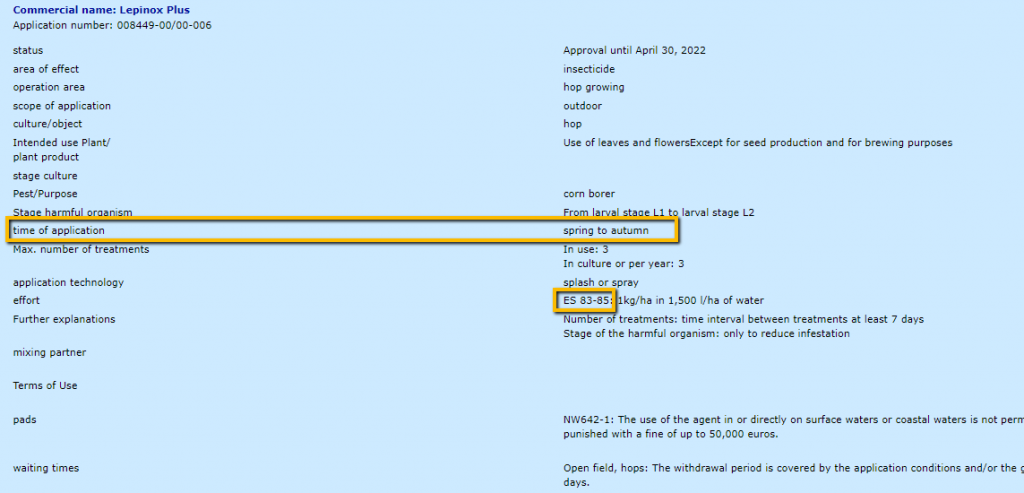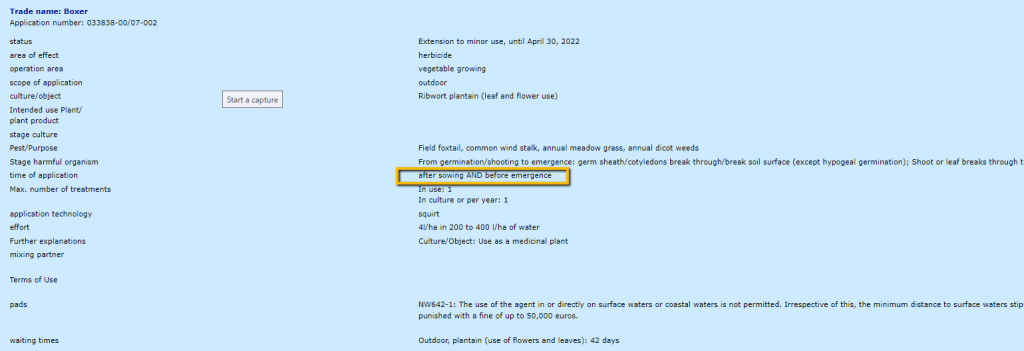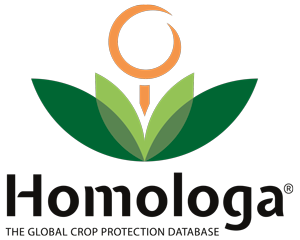Time of application information in pesticides might be described by using different events as a reference. This text aims to define a potential harmonization data entry process while converting time of application information from pesticide labels into a digital format (i.e. machine-readable).
The following eight fields cover most of the events taken as a reference for setting the time of application:
1- Crop growth stage information convertible to BBCH scale. For example, «apply at flowering» will be coded as CSB 61-70. CSB stands for convertible stage to BBCH scale, and 61-70 as the figures linked to flowering in the BBCH scale. If a label provides crop growth stage information in terms of BBCH scale (no conversion needed), it will be coded as CSBB.
2- Crop growth stage information related to plant size (height, diameter, etc.) or any other attribute which preclude conversion of crop growth stage information into BBCH abbreviated as CSN or any other crop growth scale abbreviated as CSF, CSZ, etc. (e.g. Feekes, Zadoks, etc.).
3- Target stage information, abbreviated as TS. For example, «apply at the onset of symptoms» would be coded as «TS Symptoms». If the target is a weed, the target stage information could be expressed in BBCH format. For example, «at two leaf stage of grass weeds» would be coded as TS 12.
4- Cultural practice event information, as CP. For example, «apply after pruning» would be coded as «CP > Pruning». Note that, even though crop emergence could be described using BBCH scale, it will be assigned to a cultural practice event instead. Following this procedure, all important milestones while using herbicides such as planting and emergence, will be located in the same data field.
5- Time of the year information convertible to a range of dates, abbreviated as TY. For instance, «apply in spring» will be coded as «21/03-21/06» in the Northern hemisphere and as «21/09-21/12» in the Southern hemisphere.
6- Time Frame information before or after an application or event. This field will be abbreviated as TF. It will have negative figures when an application occurs before a given event (e.g. 5 days pre-planting would be coded as «TF -5 (CP PLANT)». Positive figures will be used when a pesticide application occurs after a given event (e.g. within 5 days after planting would be coded as «TF 0-5(CP PLANT)»).
7- Crop growth stage information related to crop-plant age, which stays longer than a year in the field, abbreviated as AG.
8- Weather events as WE. For example, «prior to snow cover» would be coded as «<Snow-cover».
The following ideas describe a potential Backoffice tool development:
The aim of this design is to develop clear rules to create expressions which represent the time of application of a pesticide by using logic operators (and, or, etc.); math operators (greater than, greater than or equal to, etc.) and abbreviations. The following tables show some abbreviation examples:
| Field description | Abbreviation |
| Crop Growth Stage Information Convertible to BBCH scale | CSCB |
| Crop Growth Stage Information expressed originally using BBCH scale | CSBB |
| Crop Growth Stage Information expressed originally using Feekes scale | CSF |
| Crop Growth Stage Information expressed originally using Zadoks scale | CSZ |
| Target Stage Information | TS |
| Cultural Practice Information | CP |
| Time of the year Information convertible to a range of dates | TY |
| Time Frame Information before or after a previous application or an event | TF |
| Crop growth stages Information related to the age | AG |
| Weather events Information | WE |
| day | d |
| year | y |
| optional | op |
| Logical operators: |
| AND |
| OR |
| NOT |
Mathematical operators:
| Field type | Abbreviation |
| after, later, … | > |
| before, by, … | < |
| within | ≥ |
| generally, around, roughly… | ≈ |
| from XXX to YYY | XXX-YYY |
Additional applications will be separated by a plus symbol «+» when necessary. If they are optional, they will be separated by «op». This option and other cases from different countries, are described below:
CASE 1. Veltyma, Canada.
The following time of application description was found in the product «VELTYMA», as published in Canada (label´s PDF available below):
«Apply VELTYMA at the beginning of flowering or at the onset of symptoms. Apply a second time 10-14 days later if disease persists, or weather conditions are favorable for disease development».
Following the coding and abbreviations explained above, the three-line long time of application could be abbreviated/digitized as:
(CSB 61-65 OR TS Symptoms) + op [IF TS Persist OR WE Favorable (TF 10-14d)]
CASE 2. FBN Deltamethrin 5 EC, Canada.
«Apply prior to flowering when tents are visible, generally mid to late May»
Coded as:
CS 00-59 AND (TS Tents visible ≈ 10/05-31/05)
CASE 3. Filon, Germany.
«From the 2nd year, before budding»

Coded as:
CSN Budding AND AG ≥2y
CASE 4. MEDIA MCPA Ester 600, Canada.
«From the 3-leaf expanded to the early flag-leaf stage (wheat, barley, rye). From the 1-leaf expanded to the early flag-leaf stage (oats). From milk stage to maturity (wheat, barley, rye) Do not apply more than one treatment per year»
For wheat, barley and rye the application time information would be coded as:
CSB 13-37 OR CSB 71-99
For oats coded as:
CSB 11-37
CASE 5. Lepinox Plux, Germany.
«Spring to autumn. ES 83-85»

Coded as:
CSBB 83-85 AND TY (21/03-21/12)
CASE 6. Boxer, Germany.
Original: «nach der Saat UND vor dem Auflaufen». In English: ‘after sowing AND before emergence’

Coded as:
(CP >PLANT) AND (CP <EMERGENCE)
CASE 7. Mamet® SM Granules, Japan.
Depending on whether the rice was seeded or transplanted the application time information varies.
«7 days after (after 5 leaf stage of rice) flooding in direct dry-sowing culture of paddy rice upto 3.5 leaf of barnyard grass»
Coded as:
[CP FLOODING (TF 7d)] AND (> CSB 5) AND (<TS 13.5)
«10 days after transplanting (after 5 leaf stage of rice) up to 3.5 leaf stage of barnyard grass»
Coded as:
[CP TRANSPLANT (TF 10d)] AND (> CSB 5) AND (<TS 13.5)
CASE 8, Actinol® B, Japan.
«Growing season (onions from the 1-leaf stage onwards) to the start of tillering (weeds 1-2 leaves), but no later than 30 days before harvest».
https://cropscience.bayer.jp/ja/home/product/detail/product24407.php
Coded as: (>CSB 11) AND (<TS 11)
All the above information describes an optional time of application information harmonization process.
Please contact us for further information about any of our harmonization processes in Homologa®.

